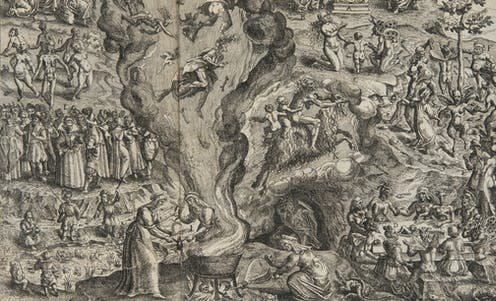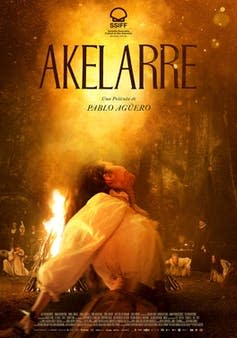Film Coven of Sisters gets a lot right about the terrible 1609 Basque witch-hunt

Pierre de Rosteguy de Lancre’s 1612 book, Tableau de l'inconstance des mauvais anges et démons (Tableau of the Inconstancy of Evil Angels and Demons), is the most sensationalist account of a sabbat, the nocturnal gathering of witches, ever written. Recounting a witch hunt the judge had conducted in the French Basque country in 1609, the book is replete with allegations of cannibalism, vampirism and a great deal of demonic sex.
Historians have not quite known what to do with de Lancre, who may have executed as many as 80 women and men as witches. They’ve either desperately tried to make him out to be the very “picture of the Catholic Reformation man”. Or they descend into unhelpful denunciations of his “attitude bordering on imbecility”.
The Spanish film Akelarre (translated as Coven of Sisters) succeeds where the historians fail, capturing de Lancre’s personality – a blend of piety, curiosity and erotic fixation with the sabbat. It takes the material from de Lancre’s book and asks the simple question: how did de Lancre obtain this wealth of material about the witches’ sabbat? (“akelarre” in Basque.)
Spellbound by the Sabbat
The film, by the Argentinian director Pablo Agüero, centres on the relationship between a Spanish judge called Rostegui (based on de Lancre) and a group of teenagers suspected of witchcraft. In an attempt to evade execution, the six teenage girls decide to tell the judge what he wants to hear. Their leader, Ana, realises that the judge is desperate to prove the reality of the sabbat. They plan to string him along, even offering to re-enact the sabbat, with the hope of winning enough time for their fathers – sailors who had gone to the New World – to return and rescue them from the judge’s clutches.
De Lancre’s Tableau highlights the contrast between elite French culture and that of the Basque border territory. It even likens the inhabitants to Native Americans from the New World. This clash of cultures is well represented in the film – Basque food, language, and dress are cursed and mocked.
Indeed, the contrast was more profound in real life. Like the film’s Spanish judge, de Lancre did not speak Basque. Every encounter had to pass through an interpreter, causing him considerable distress about possible deceptions. The film also captures this insecurity. The girls speak Spanish but switch into Basque to keep their secrets and undermine the judge’s superiority, just as de Lancre feared.
It might seem implausible that the judge desired to know every intimate detail of the sabbat but many scenes in the film are based on de Lancre’s account. The real French judges (de Lancre had a colleague) had the teenagers re-enact the dances they performed at the sabbat. The judges also asked one witch to fly off in front of them. When she could not, she promised to bring back the necessary potion the next time she went to the sabbat. Even the rather comic scene where the judge inquires about the size of the devil’s penis has roots in the Tableau.
From the “witches” perspective
While the film gets a lot right, it misses two crucial complicating factors.
The film, first of all, presents witchcraft as a novelty. The girls use the Spanish word for witch, bruja, even when speaking in Basque, as if it was unfamiliar to them. Yet Basques had a long, disturbing history of prosecuting witches. When the Spanish Inquisition first dealt with witchcraft in the late 15th century, its officials did not refer to supposed witches as brujas – they used the Basque equivalent sorginak.
Secondly, the abduction of children and teenagers by witches was a persistent part of Basque witchcraft lore on both the Spanish and French side of the border.

De Lancre did not consider his teenagers to be witches, he called them “witnesses”. Brought to the sabbat against their will, their role was to denounce those who had abducted them as witches. Although their bodies were searched for the devil’s mark – the film’s most harrowing scene – they were not usually at risk of death.
The French judges executed only one teenager, 17-year-old Marie Dindarte who made the mistake of confessing that she travelled to the sabbat on her own. De Lancre was delighted by her testimony. Marie, totally oblivious, confessed “continuously without torture”, implicating other witches. In vain, she recanted when she unexpectedly found herself on the scaffold.
These comments notwithstanding, Akelarre has got a lot right about the Basque witch-hunt’s most salient features: Pierre de Lancre’s erotic fascination with the sabbat and his strange collaboration with his teenage witnesses. Students of the early modern witch-hunt should take note of this film. And a wider audience might appreciate it more knowing how close to the truth it is.
This article is republished from The Conversation under a Creative Commons license. Read the original article.

Jan Machielsen is Senior Lecturer in Early Modern History at Cardiff University and a Humboldt Research Fellow at the TU Dresden. He is currently completing a book on the witch-hunt in the French Basque Country.

 Yahoo Finance
Yahoo Finance 